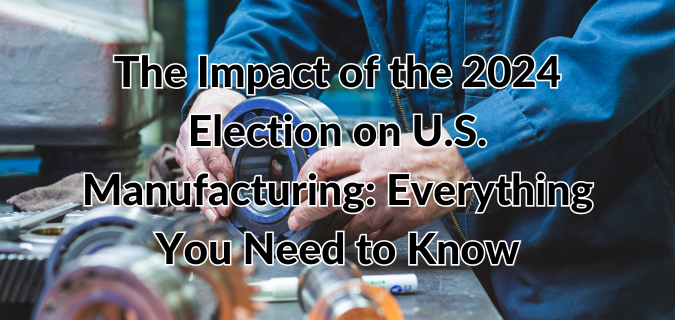
Manufacturing policies change – to some degree – with every election, be it a national election that impacts manufacturers all over the country or a local election that may only impact a few. Nationally, any time there’s a shift from one party controlling the White House to another, as the United States is experiencing as a result of the 2024 election, there is bound to be change as the new regime puts its policies into place.
Why is the 2024 Election Different from Previous Elections?
This particular election could have a bigger impact on manufacturing than previous elections, largely because Americans elected a Republican president, Donald Trump, as well as a Republican majority in both the House of Representatives and Senate. Because of this, Republicans have an opportunity to put potential changes to manufacturing into effect sooner than later and with less resistance.
One important area that will likely be affected by one-party control being able to make major changes: the Tax Cuts and Jobs Act (TCJA), which went into effect in 2017, during Trump’s first presidential term. The Democrat platform was expected to let the TCJA expire in 2025, whereas Republicans plan to make the tax provisions in the act permanent.
The Republican manufacturing agenda, as touted by Trump during his campaign, is very different from the policies of the outgoing Biden administration. The Republican agenda focuses on government efficiency, lower corporate taxes, deregulation, and tariffs. The priorities are very similar to the policies in place during Trump’s first term in office while being nearly the opposite of the Democrat agenda, which would extend current policies and prioritize sustainable energy, labor protection, and increased corporate taxes.
These agendas are quite far apart in their strategies to support U.S. manufacturing. As a result, there will undoubtedly be adjustments made across all areas of manufacturing as Republicans take over the presidency, as well as control of the House and Senate.
Key Impacts of the 2024 Election
What in particular would new Republican policies mean for manufacturing? Key impacts of the election will likely include:
- Lower corporate taxes for domestic manufacturing would encourage companies to keep their operations in the United States or, for those who have moved elsewhere, consider moving back. Part of lowering taxes will be the permanent installation of the provisions in the TCJA. Tax credits and incentives would be intended to further entice companies to do business domestically with the likelihood of higher after-tax profits. These policies are in direct contrast to what the Democrat platform promised, which was to increase corporate taxes.
- Deregulation is another stark contrast to the Democrats’ policies emphasizing sustainability and green incentives for companies who embrace renewable energy. The Trump administration will look to remove a lot of environmental regulation—Trump famously deregulated oil and fossil fuels during his first term—as well as loosen labor laws with the intent of lowering costs for manufacturers to help them increase operational efficiency. Critics say such deregulation could negatively impact sustainability and worker protection.
- Tariffs have been getting most of the headlines. Trump’s views on trade are focused on keeping jobs in the United States as well as bringing jobs back. One of his main strategies is to impose or increase large tariffs on imports, potentially even singling out certain countries (like China) for even larger tariffs. While the intent is to incentivize companies to prioritize operating domestically, opponents fear the costs of the increased tariffs will be passed on to the consumer or could even raise costs for domestic businesses that rely on a global supply chain.
How to Prepare for Changes in Steel Manufacturing Policies
Specifically with steel, there’s a general optimism in the industry that demand will increase now that the election is over. This likely would’ve happened no matter the outcome of the election, but as we move into the next four years and see policies change, we need to be able to adapt.
It’s expected Trump’s upcoming policies will be very similar to his policies from 2017 through early 2021. Manufacturers can look to see what worked—and what didn’t—during that period, with the impact of the COVID-19 pandemic during that time needing to be considered as well.
If there are lower taxes ahead, manufacturers can determine how to best use the extra after-tax profits. With deregulation, where should resources be directed to best fit the company? When it comes to tariffs, will domestic manufacturers be able to use that advantage to continue to or create more products in the United States?
These are complicated issues and not one is independent from another. When you choose Capital Steel as your steel manufacturing and distribution partner, our expertise and experience gives you stability in this ever-changing industry. Contact us today to start the conversation.





